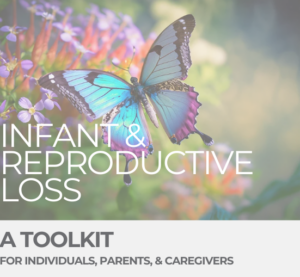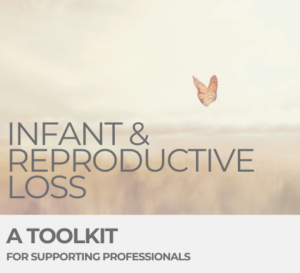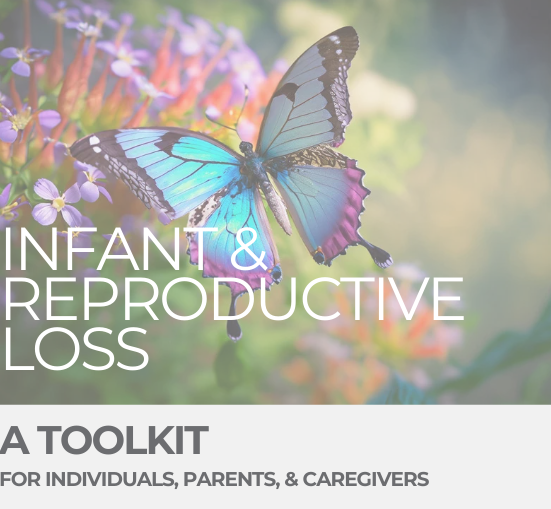Posts Tagged ‘infertility’
Infant & Reproductive Loss Toolkit [Free Downloadable PDFs for Individuals and Professionals]

Navigating life, death, and loss can be overwhelming. Mental health professionals designed this toolkit for individuals, parents, caregivers, and families navigating perinatal and reproductive loss.
Reactions to pregnancy and reproductive loss are as unique as fingerprints. Some can process the experience relatively quickly, while others experience unrelenting pain and grief.
We hope that this toolkit can be used to add tools to your toolbox and offer words of support, guidance, and care as you navigate life after loss.
Download the Infant and Reproductive Loss Toolkit for Individuals HERE.

Navigating life, death, and loss can be overwhelming. This toolkit was designed by mental health professionals for other professionals who support individuals during their reproductive years and beyond.
It contains information about grief and navigating the impact of loss alongside your clients.High-quality grief care includes compassionate and open communication, informed choice and individualized care. Compassionate communication, the most important element, is required in all aspects of care throughout and following loss.
Download the Infant and Reproductive Loss Toolkit for Supporting Professionals HERE.
Shadowloss: loss in life
By Alyssa Warmland
Shadowloss is a term developed by Cole Imperi, a thanatologist and the founder of The American School of Thanatology. It describes the types of loss we feel in life, rather than the loss of life. Shadowlosses are things like divorce or the end of a long-term relationship, infertility, a medical diagnosis, losing a job, or the loss of some other relationship or thing. It’s a loss that impacts the life of an individual, as well as their social network in their life.
Sometimes, the loss of a being coexists with shadowloss. For example, when a loved one dies, families are often tasked with sorting through the person (or animal)’s belongings. When my dog died, I remember packing her bowls, her toys, her leash, and her collars away in a box I made space for in my crowded apartment because I couldn’t stand the loss of throwing them out. I remember holding her favourite toys and feeling deeply in grief. The “big loss” was my beloved dog, but the shadowloss was when I got rid of some of her belongings and how hard that piece was. It felt like a tug in the pit of my stomach when I turned towards the wall where her water dish used to sit, only to see an empty bit of wall.
Another example of shadowloss in my life was when I was fired from a job at a women’s shelter. I’d thought, all through my undergrad, that I would work in one. I worked hard to get my gender studies degree and to volunteer with feminist organizations that targeted violence against women. And, after applying four or five times, I finally got the job. I loved it, although the rest of the staff was far more conservative than I am and I sensed that I was not a great fit, in spite of my knowledge and my passion for the work. I was fired, just before the end of my probation, and refused an explanation as to exactly why. I was devastated. Not only was I losing a job, I felt as though I was losing a dream and a sense of self. Years, and a whole career, later, I still experience huge waves of grief related to that loss.
What we know about types of loss is that we experience grief related to them in very similar ways. Waves of sadness, anger, and the sense that something/someone is missing are a few things that can come up with “big loss” and with shadowloss. As with any type of grief, it’s not particularly useful to rank and compare types of loss or experiences of grief. But having language to describe the experience of grief associated with the loss of a thing or part of someone/their life can be useful. This allows us to acknowledge those losses as ones where we leave ourselves some space to grieve. It can also be another opportunity to connect in this life where there are shared human experiences like the complex plurality that is grief.
Reflections on Mother’s Day
By Jessica Milette, MSW, RSW
The signs of spring start to show up: the bird calls, sleepy daffodils and tulips waking up from their slumber, the trees beginning to bud ready to shade us with their leaves all season. And then, the flood of Mother’s Day emails start crashing into our inboxes.
Mother’s day is a holiday where we show appreciation and care for the maternal roles in our lives. However, this holiday can feel very overwhelming for those of us who are grieving the death of a mother figure, a mother grieving their child, or those of us grieving the loss of not being able to become mothers ourselves. The ads, commercials, and displays at the store, designed to be appealing and inviting become a painful grief trigger as we go about our day, our minds and hearts going to the person we’re grieving who isn’t alive to receive their flowers or gifts. Feeling as if our grief is heightened on holidays or times of celebration is a natural reaction to have. Often around these times of the year we gather with our loved ones, and our special person’s absence feels amplified.
Over the years, my grief reactions around mother’s day continue to change. At first, it was like a black looming cloud and I would avoid anything to do with Mother’s Day. Over time, I still have had hard Mother’s Days but the day looks much different. I may write to my mother, choose to ignore the day and do things unrelated to Mother’s Day, make a comforting meal from my childhood, or participate in a memorial event on Mother’s Day. Regardless of what I choose to do, or not do on Mother’s Day I make sure to give myself the space and compassion to rest and recover – grief can be exhausting.
There is no right or wrong way to grieve, nor how to go through Mother’s Day. Our relationship as mothers and children is unique, so too will be our grief. The following ideas may be how you’d like to take time to honour the person you’re remembering and grieving on Mother’s Day:
-Unsubscribing from Mother’s Day emails (some companies have a special opt-out message for folks to unsubscribe from these types of emails)
– Ignoring Mother’s Day altogether and doing something that fills you up (it could be going to a movie your person may have never wanted to go to or taking a long hike)
– Creating an altar with photos, keepsakes, and favourite things of your person
– Lighting a candle in their honour
– Writing them a card, updating them on your life and reflecting on your relationship
– Creating a new tradition or ritual to replace Mother’s Day
– Packing your day with connection and activities with trusted others who support you in your grief
– Having a day of nothing: allowing yourself to do what your heart is telling you (a bath, a nap, a cry)
Sometimes our grief may feel heaviest in anticipation of Mother’s Day or on Mother’s Day itself. As we enter May and Mother’s Day approaches, I wish for you to be compassionate towards yourself and move through the day in the way that fits your heart and relationship best.



